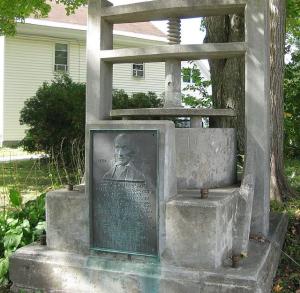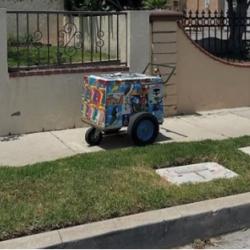From December 10, 2014, “A really big wheel of cheese, Southern Baptists, the Bible, and slavery”
John Leland was not, technically, a Southern Baptist. He was born in Massachusetts, for one thing. And for another he died in 1841, several years before the Southern Baptist Convention split away from other Baptists in defense of slave-owners’ rights to serve as missionaries. But Leland also spent many years building churches and ministering in Virginia where he served in a leadership role as a member of the Baptist General Committee for that southern state.
Leland is remembered today, when he is remembered at all, for two events in the presidency of Thomas Jefferson. He helped to found the Baptist association in Danbury, Connecticut, to which President Jefferson sent his famous 1802 Letter to the Danbury Baptists — the letter in which Jefferson wrote of the First Amendment as “building a wall of separation between Church & State” and reaffirmed “the rights of conscience” as a natural right of all people.

More memorable, if less consequential, was Leland’s response to that letter, provided in the form of cheese. A lot of cheese. As an expression of gratitude to Jefferson for his shared commitment to religious liberty, John Leland organized the creation of the Cheshire Mammoth Cheese — a 1,200-pound, four-foot wide cheese wheel made from the milk of every cow in Cheshire, Mass., where Leland was then serving as a pastor.
The big cheese had to be transported by sleigh, and it was John Leland himself who drove that sleigh the 500 miles from Massachusetts to Washington. The journey took three weeks, with the strange sight of the Mammoth Cheese drawing crowds at each stop along the way. As a Baptist preacher, Leland couldn’t resist such crowds, and he preached his way from Massachusetts to the White House, standing in the pulpit of his sleigh next to a ginormous cheese wheel which bore the inscription “Rebellion to tyrants is obedience to God.”
But the Cheshire Mammoth Cheese was only the second most audacious thing John Leland attempted.
His more audacious project was undertaken during his years of ministry in Virginia. In 1789, Leland authored a resolution put before the Baptist General Committee of Virginia. That resolution called for a “great Jubilee” and the abolition of slavery in the state. It also declared slavery to be a “a violent deprivation of rights of nature” and “contrary to the word of God.”
Leland’s resolution, remarkably, was initially met with some enthusiasm. Consider that for a moment — it’s more startling than even the image of a sleigh-riding itinerant preacher bearing a half ton of hand-crafted, revolutionary cheese. In 1789, in the state of Virginia, a gathering of southern Baptists who were not yet officially Southern Baptists entertained a proposal from a Massachusetts abolitionist that would have freed all their slaves and declared the practice of slavery in Virginia to be “contrary to the word of God.”
Leland wasn’t laughed out of the convention and sent packing back to New England. His fellow Baptists in Virginia took this resolution seriously. They considered this proposal as something they might actually affirm and embrace and do. Leland’s resolution was sent out to the various regional Baptist associations throughout the state.
That’s when the push-back started.
The good Christians of the Strawberry Baptist Association, near Lynchburg, did not explicitly dispute the resolution’s argument that slavery was incompatible with scripture and human rights, but they worried that Leland’s Jubilee would create a humanitarian crisis among all those abruptly unemployed former slaves. The pious devout of the Roanoke Association fretted that the General Committee’s resolution took too simple a view of what they saw as a “very abstruse … set of complex circumstances.” Surely such a complicated issue was best left up to local congregations to decide.
Leland’s resolution was returned to the statewide General Committee in 1792, which quickly voted to dismiss it.
The non-cheese-related history recounted above is taken from Garrett Ryland’s 1955 book, The Baptists of Virginia, 1699-1926. Ryland says that this same pattern — initial support for abolition and Jubilee followed by local resistance and ultimate reversal — was repeated at the local and regional level in Baptist associations throughout the state. The Ketocton Association, for example, adopted a plan for the “gradual abolition of slavery” in 1796. Angry resistance from local congregations led to the repeal of that plan just two years later.
The resistance to Leland’s proposal from the regional associations shows that it probably never really had a chance, but this is still a tantalizing story. In 1789, the Baptists of Virginia came to a crossroads and saw that something else, some other way, might be possible. And they paused, for just a moment at least, to consider that before passing by on the other side.












